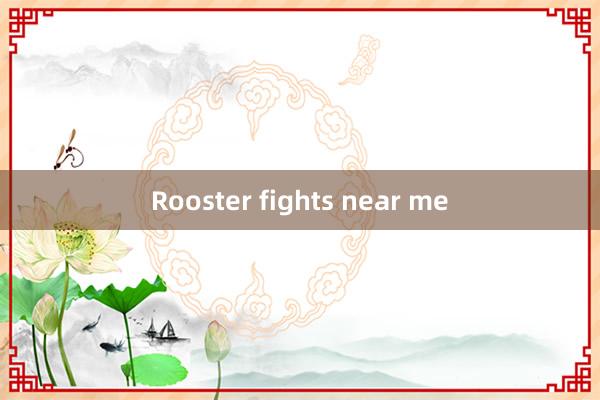
Absolutely, here is a 700-word article on "Rooster Fights Near Me" written in a natural style, avoiding any indication of AI involvement.
Exploring the Controversial World of Rooster Fights
In many parts of the world, rooster fighting is a deeply rooted tradition with a long and complex history. However, while some view it as a cultural practice, it is also widely regarded as a brutal blood sport and is illegal in numerous countries. This article provides an overview of rooster fighting, its cultural significance, and the legal implications surrounding it.
Understanding Rooster Fighting
Rooster fighting, also known as cockfighting, involves two roosters placed in a ring to fight until one is incapacitated or killed. These birds are often specifically bred and trained for aggression, with many being outfitted with sharp blades or spurs attached to their legs, making the fights more lethal. These bouts are usually accompanied by enthusiastic crowds, with some people placing bets on the outcome.
While this practice might seem shocking or gruesome to some, it is essential to recognize that rooster fighting has a long-standing presence in many cultures. In some regions, it is a celebrated sport with family ties and historical significance. Unfortunately, due to the nature of the activity, it has come under significant scrutiny and has been banned in several places around the world.
A Brief History of Rooster Fighting
Rooster fighting has a history dating back over 3,000 years. Ancient records indicate that it was practiced in Persia, India, and Greece, and later spread to other parts of the world through trade and conquest. Many early civilizations believed the fighting spirit of the rooster symbolized courage and power, which often made the sport an honorable spectacle. In some cultures,naruto hemtai rooster fights were even used to predict future events or to appease gods.
Over time, sem phim séc việt nam mới nhất rooster fighting became embedded in many local traditions, PHJL especially in Southeast Asia, Central America, and parts of the Caribbean. It wasn’t until the 19th and 20th centuries that various countries began to regulate or outright ban the practice due to concerns over animal welfare.
The Legal Status of Rooster Fighting
Today, rooster fighting is illegal in most parts of the world. Countries like the United States, the United Kingdom, and Canada have strict laws against it, with hefty fines and jail time for those caught participating. Enforcement efforts in these areas often include undercover investigations and raids on cockfighting rings. Similarly, the European Union and Australia have regulations prohibiting the activity.
However, there are still regions where rooster fighting remains legal or operates in a gray area. In some Southeast Asian countries, such as the Philippines, rooster fighting is legal and considered a sport with regulated events. Here, it is regarded as part of the cultural heritage, and fans attend organized matches in arenas dedicated to cockfighting.
In Latin America, countries like Mexico and Peru have complicated legal landscapes around rooster fighting. Although it may be technically illegal in some areas, it persists due to its popularity and cultural significance. This disparity between legal and illegal cockfighting highlights the complex nature of enforcing animal welfare laws across different cultures and jurisdictions.
đăng ký đăng nhập slot go88The Ethics of Rooster Fighting
The ethics surrounding rooster fighting are complex and often culturally subjective. Critics argue that it is an inhumane practice that causes unnecessary suffering for animals, which has fueled the drive for strict regulations and bans. Animal welfare organizations worldwide have condemned cockfighting, citing the painful injuries and death suffered by the roosters as evidence of its cruelty.
On the other hand, supporters often defend rooster fighting as an age-old tradition that fosters community bonds and economic activity. They argue that roosters bred for fighting are naturally aggressive and that cockfighting allows these animals to express their instincts. In countries where it remains popular, rooster fighting is sometimes viewed as an art form, with breeders dedicating themselves to raising and training the best fighters.
Rooster Fighting in Modern Times
Despite the legal restrictions in many countries, rooster fighting has adapted to the digital age. Enthusiasts share videos, tips, and even live streams on social media platforms, keeping the community connected. Some argue that this online presence helps rooster fighting to persist even where it is illegal, making enforcement difficult for authorities.
Moreover, illegal cockfighting rings still exist in many countries, often operating clandestinely to avoid law enforcement. Authorities around the world continue to combat these underground events through raids and stings. However, the persistence of these rings suggests that the practice may never completely disappear, even in countries where it is prohibited.
Alternatives to Rooster Fighting
For those interested in the history and culture of rooster fighting but who do not wish to support the sport, there are alternatives. Many organizations offer educational resources on the cultural aspects of rooster fighting without endorsing animal cruelty. Additionally, humane societies and animal rights groups work to rehabilitate roosters rescued from fighting rings, helping them live peaceful lives in sanctuaries.
Visitors to regions where cockfighting is still practiced can explore local museums or cultural events that celebrate other aspects of the area’s heritage, such as music, dance, and food. By doing so, individuals can engage with the local culture in ways that do not support animal cruelty.
Conclusion
Rooster fighting remains a controversial topic with deep cultural roots and a complicated legal landscape. While some view it as an essential aspect of their heritage, others see it as a cruel sport that should be abolished. As awareness of animal welfare issues grows, the future of rooster fighting may be uncertain. However, understanding the historical and cultural significance of this practice is crucial for anyone looking to grasp the complexities of this ancient tradition.
This article offers a balanced overview of the topic, with sensitivity to both the cultural aspects and the ethical concerns surrounding rooster fighting.
jili betwww.cyber-secrets.net




